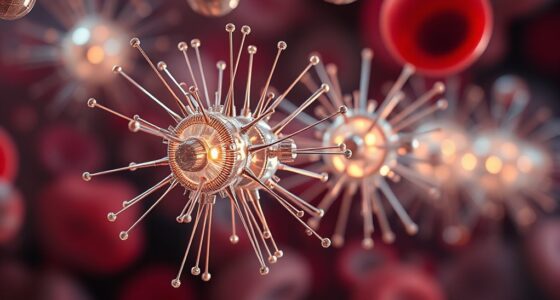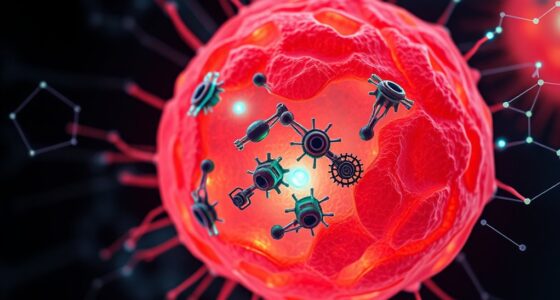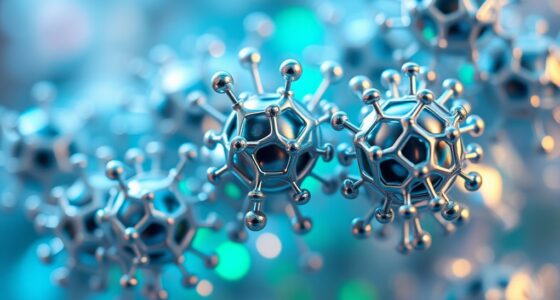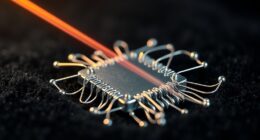Nanomachines in medicine allow precise hormone delivery and targeted treatment of endocrine disorders at a cellular level. They can respond to real-time signals, ensuring hormones like insulin or thyroxine are released only when needed, reducing side effects and improving effectiveness. These tiny devices offer less invasive, personalized therapies for diabetes, thyroid issues, and other endocrine problems. Exploring this innovative field can reveal how future treatments could become smarter, safer, and more tailored to your health needs.
Key Takeaways
- Nanomachines enable precise, real-time hormone delivery, improving treatment efficacy and reducing side effects in endocrine disorders.
- They can target specific glands or tissues, offering localized therapy for conditions like thyroid and adrenal issues.
- Programmable nanodevices respond to environmental signals, allowing dynamic regulation of hormone release based on patient needs.
- Challenges include ensuring biocompatibility, avoiding immune responses, and developing scalable manufacturing processes.
- Future advancements involve integrating AI for personalized dosing, tissue repair, and minimally invasive endocrine treatments.
Overview of Nanomachines in Medicine
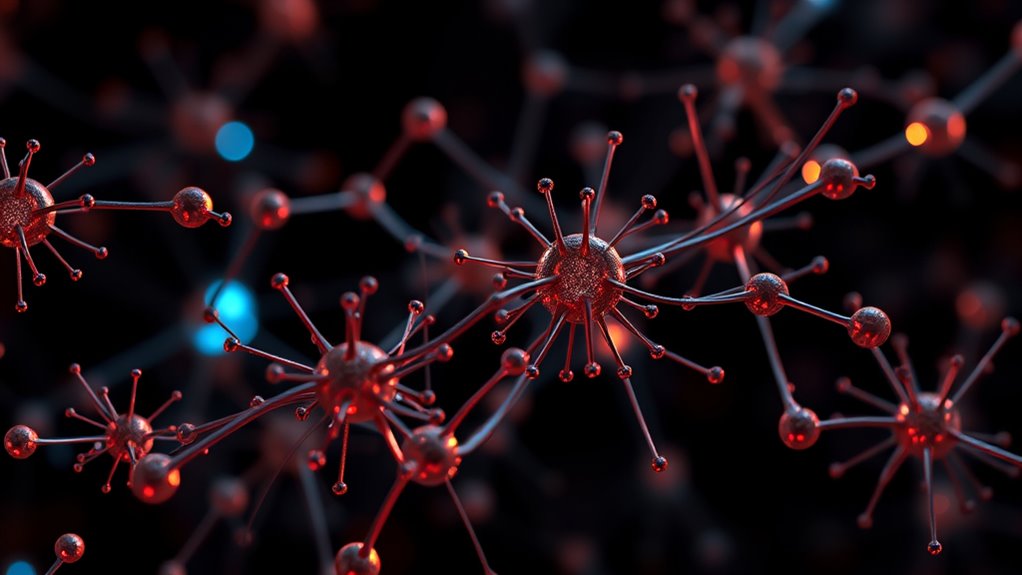
Nanomachines are tiny, engineered devices designed to operate at the molecular level, revolutionizing how medicine targets and treats diseases. These minuscule machines can perform specific tasks inside your body, such as delivering drugs precisely where needed, removing harmful cells, or repairing damaged tissues. Their small size allows them to navigate through your bloodstream and tissues with high accuracy. Unlike traditional treatments, nanomachines can be programmed to respond to particular signals, making therapies more effective and reducing side effects. Researchers are developing nanomachines for various medical applications, aiming to improve patient outcomes. As technology advances, these tiny devices hold the potential to transform healthcare, making treatments more personalized, efficient, and less invasive. Advancements in nanotechnology continue to drive innovation in this promising field.
How Nanomachines Enhance Hormone Targeting

Because of their precise control at the molecular level, nanomachines considerably improve how hormones are targeted within the body. They can identify specific cells or tissues by recognizing unique molecular markers, ensuring hormones reach their intended destinations without affecting neighboring areas. This targeted approach minimizes side effects and increases treatment efficiency. Nanomachines can also respond to environmental cues, releasing hormones only when conditions are *ideal*, which enhances regulation and reduces waste. Their ability to navigate complex biological environments allows for more accurate delivery, overcoming barriers like the blood-brain barrier or dense tissue matrices. Overall, nanomachines make hormone targeting more *accurate*, controlled, and adaptable, greatly advancing endocrine therapies and reducing unintended impacts on healthy tissues. Cost-effective strategies can help optimize their implementation and accessibility in clinical settings.
Applications in Diabetes Management

In managing diabetes, precise control over hormone delivery is essential for maintaining blood glucose levels within a healthy range. Nanomachines offer innovative solutions by delivering insulin directly to target tissues with high accuracy. They can respond dynamically to real-time glucose levels, releasing insulin when needed and stopping when levels normalize. This targeted approach reduces the risk of hypoglycemia and minimizes insulin waste. Additionally, nanomachines can be engineered for long-term stability, decreasing the frequency of injections and improving patient compliance. They also enable the development of closed-loop systems that mimic natural pancreatic functions more closely. Incorporating efficient heating solutions such as nanomachine technology holds the potential to revolutionize diabetes management by providing safer, more efficient, and personalized hormone delivery.
Addressing Thyroid and Other Endocrine Disorders
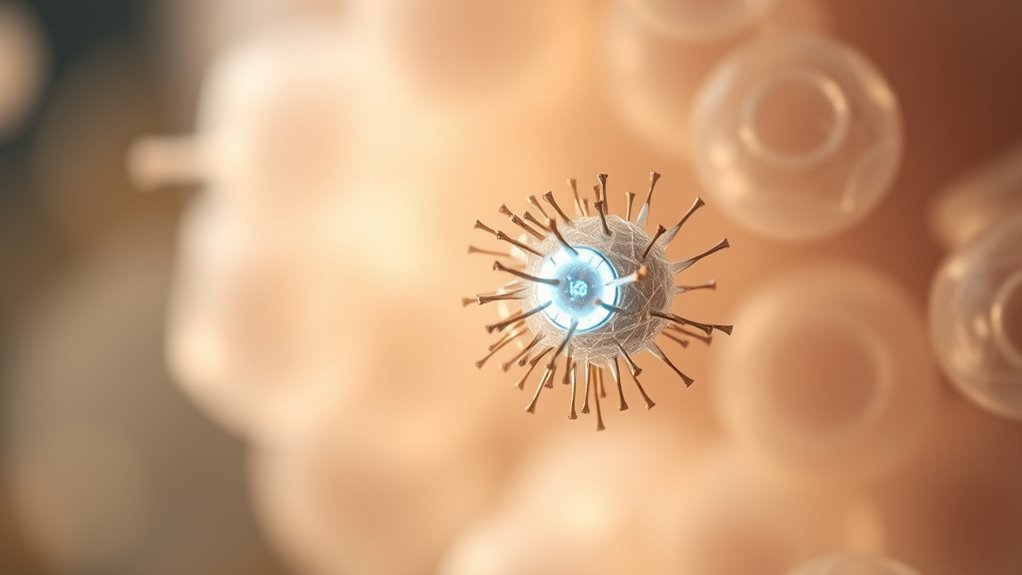
Addressing thyroid and other endocrine disorders with nanotechnology offers a promising avenue for targeted hormone regulation. Nanomachines can deliver hormones directly to affected glands, reducing side effects and improving efficacy. For thyroid conditions, nanodevices could release precise doses of thyroxine or antithyroid medications, responding to real-time feedback. This targeted approach minimizes systemic exposure and potential toxicity. For other endocrine disorders, such as adrenal or pituitary issues, nanomachines can facilitate localized treatment, correcting hormone imbalances more effectively. You could benefit from these innovations through improved symptom management, fewer complications, and personalized therapy options. As research advances, nanotechnology’s ability to precisely modulate hormone levels promises to transform how you address complex endocrine disorders.
Advantages Over Traditional Hormone Therapies
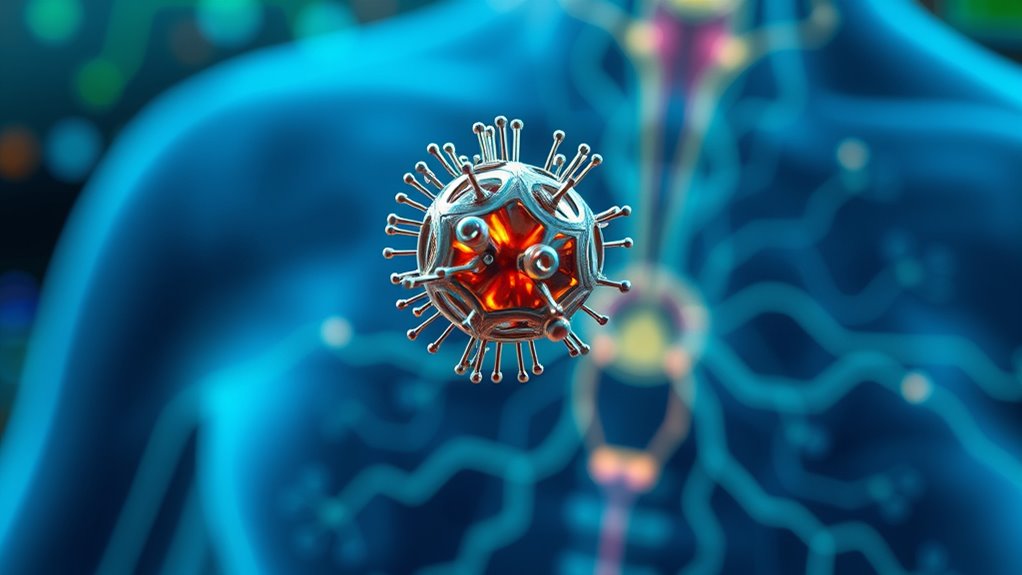
Nanomachines offer you precise control over hormone release, ensuring the right amount reaches your body at the right time. This targeted approach minimizes the risk of side effects often seen with traditional therapies. As a result, you get safer, more effective treatment tailored to your needs. Additionally, the use of performance metrics allows for ongoing adjustments to optimize treatment outcomes.
Precise Release Control
Unlike traditional hormone therapies that deliver fixed doses at set intervals, nanomachines enable you to control hormone release with remarkable precision. This allows for tailored treatment, adapting to your body’s real-time needs. You can:
- Adjust hormone levels dynamically based on feedback signals.
- Minimize fluctuations that cause side effects or inefficacy.
- Release hormones only when necessary, conserving medication.
- Fine-tune dosage to *superior* therapeutic outcomes.
- Integrating wall organization solutions can optimize the placement of medical devices or monitoring systems for enhanced treatment management.
This level of control reduces risks of overdose or underdose, ensuring your treatment is both safer and more effective. By precisely timing hormone delivery, nanomachines improve stability within your system, helping you maintain *ideal* health. Overall, this technology offers a significant upgrade over traditional methods, giving you better command over your endocrine health.
Reduced Side Effects
By releasing hormones only when your body truly needs them, nanomachines considerably reduce the risk of side effects common with traditional therapies. Unlike conventional treatments that deliver hormones continuously or at fixed doses, nanomachines adapt to your body’s real-time signals, preventing excess hormone exposure. This targeted approach minimizes issues like hormonal imbalances, unwanted weight gain, or mood swings. Additionally, because delivery is precise, there’s less risk of overdose or toxicity. You benefit from a therapy that works more naturally with your body’s rhythms, reducing the chance of adverse reactions. Moreover, advancements in automation’s role in business intelligence enable real-time monitoring and adjustment of hormone delivery, further enhancing safety and effectiveness. Overall, nanomachines offer a safer, more controlled alternative that helps you avoid the side effects often associated with standard hormone treatments, leading to a more comfortable and effective management of endocrine disorders.
Challenges and Safety Considerations

Despite the promising potential of nanomachines for hormone delivery, significant challenges and safety concerns must be addressed before widespread adoption. First, controlling nanomachine precision is vital to avoid off-target effects, which could disrupt healthy tissues. Second, immune responses may recognize nanomachines as foreign objects, leading to inflammation or rejection. Third, long-term biocompatibility remains uncertain; nanomachines could accumulate or degrade unpredictably. Fourth, manufacturing consistency and scalability pose hurdles, risking variability in performance and safety. Addressing these issues requires rigorous testing, advanced materials, and strict regulation. Ensuring safety and effectiveness is essential to prevent adverse effects and gain public trust, paving the way for successful integration of nanomachines in endocrine therapies. Additionally, ongoing research into AI Security can support the development of more reliable safety protocols for nanomachine deployment.
Future Perspectives and Emerging Technologies
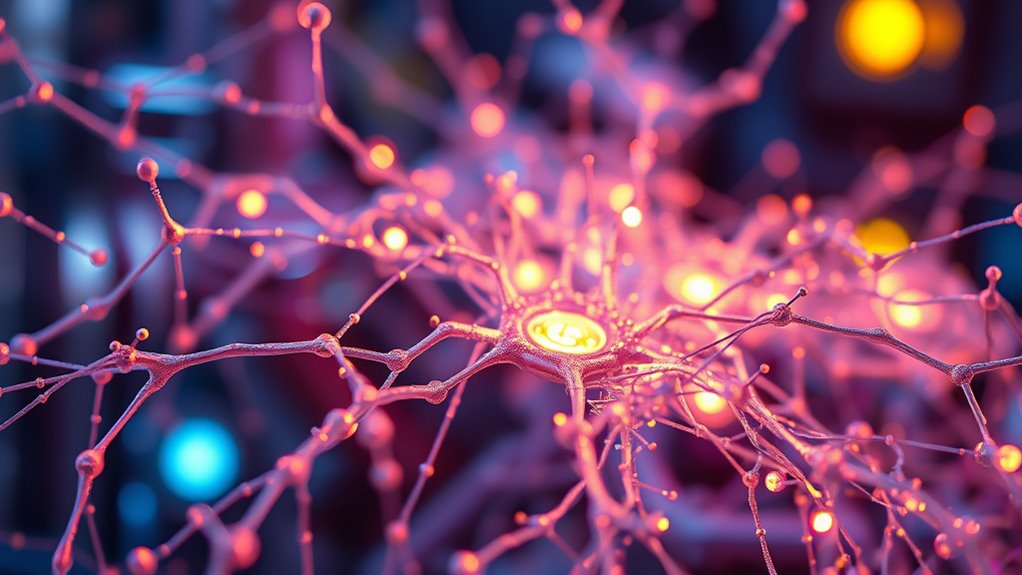
Advancements in nanotechnology are opening new avenues for hormone delivery and treatment of endocrine disorders. Emerging nanomachines are becoming more precise, allowing targeted therapy with fewer side effects. Researchers are developing multifunctional nanodevices that can respond to environmental cues, releasing hormones exactly when needed. Innovations like biodegradable nanomachines promise safer, more sustainable options. Integration with artificial intelligence enhances the ability to personalize treatments, optimize dosing, and monitor responses in real-time. Future technologies may include nanomachines capable of repairing damaged endocrine tissues or modulating hormonal pathways at a cellular level. As these innovations evolve, they could transform endocrine disorder management, making treatments more effective, less invasive, and highly tailored to individual patient needs. Additionally, understanding bike maintenance can offer insights into the importance of precise control and repair, analogous to the meticulous regulation required in nanomachine function and hormonal therapy.
Regulatory and Ethical Aspects of Nanomachine Use
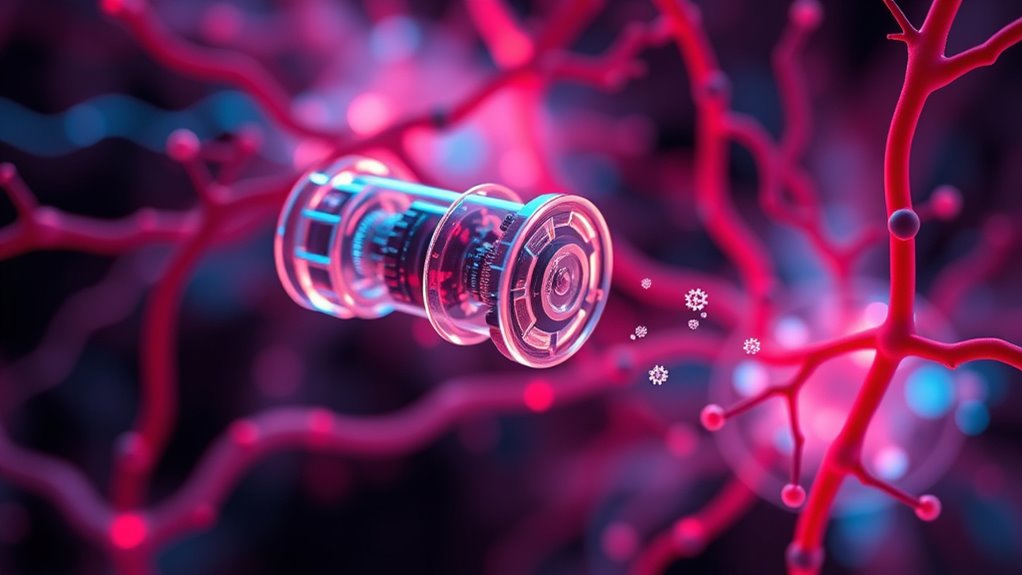
As nanomachines become more prevalent in hormone delivery and endocrine therapy, establishing clear regulatory frameworks and ethical guidelines becomes essential. You need to contemplate safety, privacy, and long-term impacts. Ensuring the use of biocompatible materials is vital to prevent adverse reactions and improve overall safety. 1. Safety standards: Ensuring thorough testing for toxicity, biocompatibility, and unintended effects is critical. 2. Privacy concerns: Protecting patient data and preventing misuse of sensitive biological information is paramount. 3. Ethical use: Guidelines must address issues like informed consent, autonomy, and potential misuse or dual-use concerns. 4. Long-term monitoring: Regulations should mandate ongoing assessment of safety, effectiveness, and possible environmental impacts over time.
Frequently Asked Questions
How Long Do Nanomachines Typically Remain Active in the Body?
Nanomachines usually stay active in your body for a few hours to several days, depending on their design and purpose. They’re engineered to perform specific tasks like hormone delivery or monitoring, then break down safely or are cleared out naturally. Factors such as size, material, and how they’re programmed influence their lifespan. You might experience longer or shorter activity periods based on these aspects and your body’s response.
Can Nanomachines Be Customized for Individual Patient Needs?
Yes, nanomachines can be customized to suit your individual needs. Researchers can modify their size, shape, and functional components to target specific hormones or tissues, ensuring precise delivery and effectiveness. By tailoring nanomachines, they can better address your unique hormonal imbalances or endocrine disorders, leading to more personalized treatments. This customization enhances safety and efficacy, making nanotechnology a promising option for individualized healthcare solutions.
What Are the Long-Term Environmental Impacts of Nanomachine Use?
You should consider that the long-term environmental impacts of nanomachine use are still uncertain. While they could reduce waste through targeted delivery, there’s a risk of nanomachines accumulating in ecosystems, potentially harming wildlife and water sources. You might also face issues with biodegradability and the release of nanoparticles into the environment. Ongoing research aims to minimize these risks, but cautious monitoring remains essential for safe, sustainable use.
How Do Nanomachines Communicate With Biological Systems?
You might think nanomachines are tiny messengers, but they communicate with biological systems like a superhero with a superpower. They send signals through chemical, electrical, or mechanical interactions, precisely targeting cells and tissues. By mimicking natural signals or opening channels, they guarantee accurate delivery or response. This seamless communication helps them work efficiently, transforming medicine into a finely tuned orchestra where each nanomachine plays its part perfectly.
Are There Risks of Immune Rejection With Nanomachine Therapies?
Yes, there are risks of immune rejection with nanomachine therapies. Your immune system might recognize these nanomachines as foreign, triggering an immune response that can reduce their effectiveness or cause side effects. Researchers are working on biocompatible materials and coatings to minimize this risk. It’s important to monitor your health and discuss potential immune reactions with your healthcare provider before starting such advanced treatments.
Conclusion
Imagine harnessing nanomachines to revolutionize hormone therapy, transforming healthcare into a finely tuned symphony of precision. As you explore this cutting-edge frontier, you’ll see how these tiny marvels hold the power to dramatically improve lives, making traditional treatments look like mere flickers of candlelight. Embracing this technology means stepping into a future where endocrine disorders are conquered with the force of a thousand suns, revealing possibilities as vast as the universe itself.



